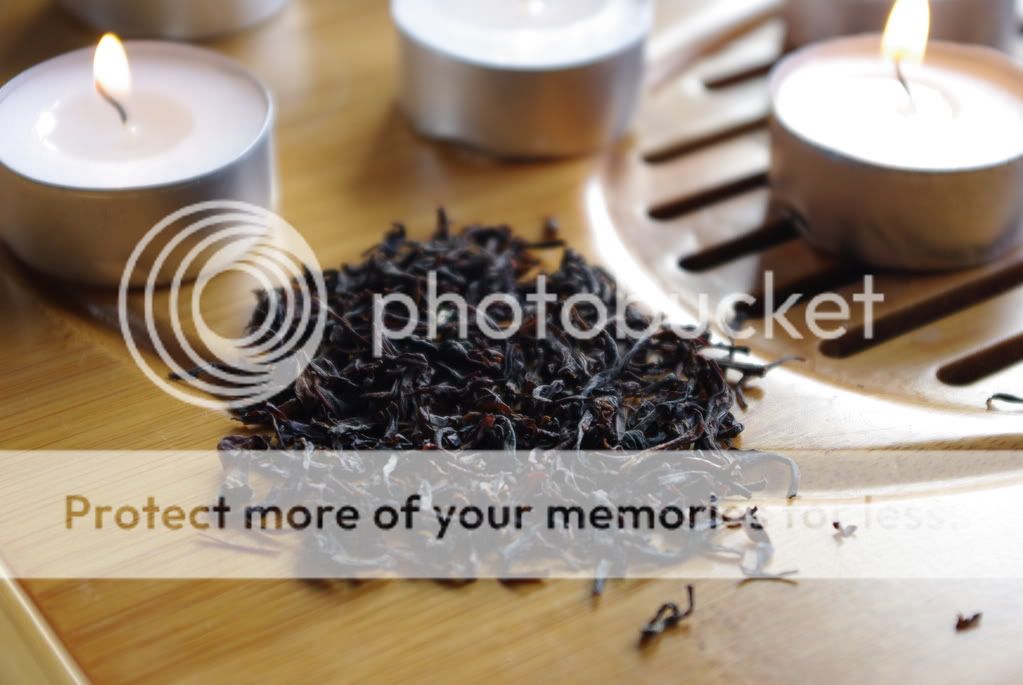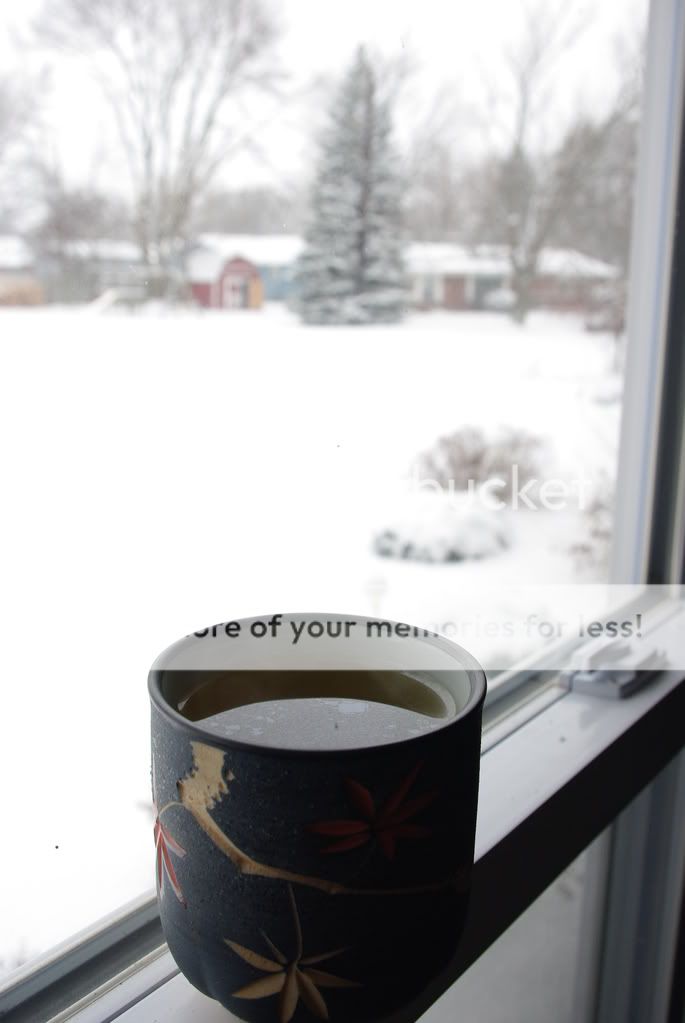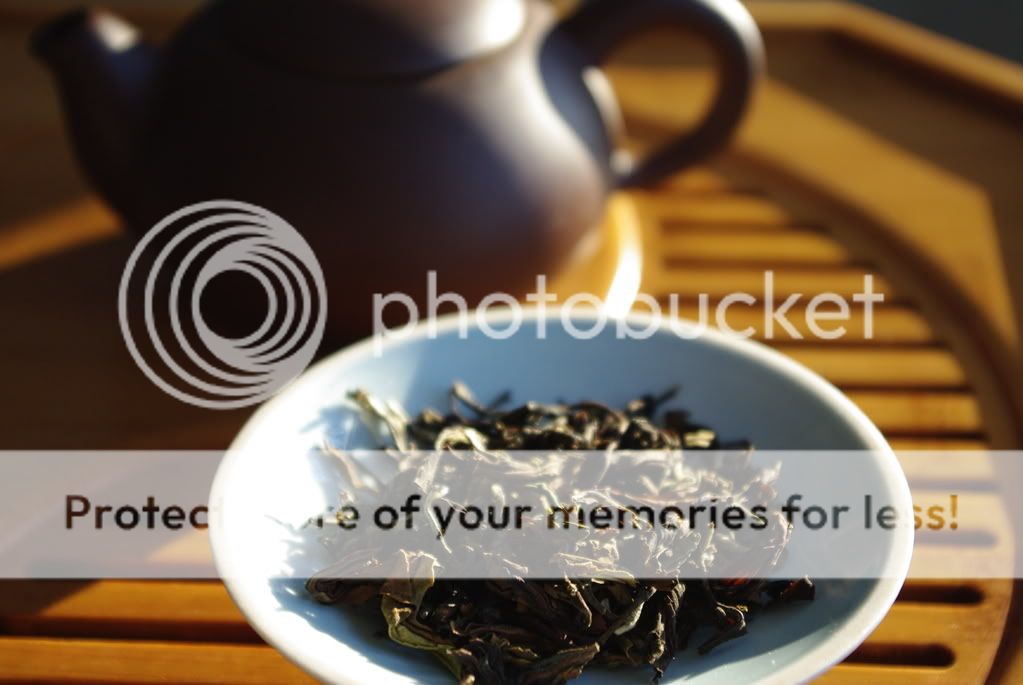Type: Black
Origin: Chamraj Estate in Nilgiris, India
Price: $4.95 for 1oz; $13.95 for 4oz.
Vendor: The Simple Leaf
Brewing Method: 1 teaspoon of leaves (2.5 – 3.0 grams), 1 cup of filtered water, heated to 190°F-208°F, steeped for 4-5 minutes.
Overall Score: 4.4 out of 5
Black Frost is a black tea from India. The leaves are small rolled bits. However, I say “small” compared to the other teas from The Simple Leaf – the leaves are far from being just dust. The aroma of the dry leaves is very hearty and bold. I smell a lot of earthy tones, as well.
The aroma of the tea is smoky and woodsy. Not as smoky as an Assam tea, though. The color of the liquor is a deep orange.


This tea has such a smooth taste to it. There was no sharp kick (that I was expecting with a black tea) when it first hit my tongue. It was almost like it glided all the way down. The overall taste is earthy with a little smokiness. I didn’t find this brew bitter, but my mouth was left a little dry afterwards.
I would say this is a nice hearty, full bodied tea, but mellower than an Irish Breakfast type of tea – meaning that it is not too harsh. I am sure it would stand up nicely to milk or sugar.
Sunday, January 25, 2009
The Simple Leaf’s Black Frost Review
Wednesday, January 21, 2009
The Simple Leaf’s Dawn Review
Type: Black
Origin: Abali Estate in Arunachal Pradesh, India
Price: $4.95 for 1oz; $13.95 for 4oz.
Vendor: The Simple Leaf
Brewing Method: 1 teaspoon of leaves (2.5 – 3.0 grams), 1 cup of filtered water, heated to 190°F-208°F, steeped for 4-5 minutes.
Overall Score: 4.4 out of 5
The aroma of the brew is malty with a slight hint of smokiness in the background. The smell of this tea is rather mellow for a black tea – I really have to put my nose to the cup to find it. The liquor is a nice copper color.

The taste is very smooth. The brew has a pleasant chocolaty or malty taste to it. It is not too bold, for being a black tea. However, the flavor does have a nice kick to it, which lingers for a while, and I’m sure it will stand up well to milk or sugar. Bitterness doesn’t seem to be a problem; though, astringency is.
All in all, this is a hearty tea with a gentler side – by that I mean it is a nice pick me up, but it isn’t too bold. Also, I found the chocolaty taste was definitely a plus.
Sunday, January 18, 2009
The Simple Leaf’s Tankha Review
Type: Oolong
Origin: Phoobsering Estate in Darjeeling, India
Price: $4.95 for 1oz; $13.95 for 4oz.
Vendor: The Simple Leaf
Brewing Method: 1 teaspoon of leaves (2.5 – 3.0 grams), 1 cup of filtered water, heated to 170°F-180°F, steeped for 2-3 minutes.
Overall Score: 4.9 out of 5
Tankha is an oolong tea from Darjeeling, India. Just as I suspected, the tea leaves for this blend are whole, long, rolled leaves. They are dark in color and smell vegetal, fresh, and fruity. I said this with the last oolong that I tried from The Simple Leaf and it holds true this time as well – the dry leaves smell more like green tea than oolong tea (which is not a bad thing).
The tea tastes very sweet and fruity. There is a nice briskness to it, as well. A slight earthy or woodsy aftertaste lingers for only a short while. Bitterness or astringency is not a problem for this blend. I would actually say it is quite smooth.
I really liked this one. Normally, I really have to be in the mood to drink an oolong, but not in this case. I love the slight woodsy flavor which gives it a very light smoky taste, but the fruitiness of it keeps it sweet and not too harsh. I think I may have a new oolong favorite.
While having some technical difficulties uploading this post, I made three infusions of this tea. There was no loss of flavor in the second or third infusion and I am sure I could have made more.
Wednesday, January 14, 2009
Why Must I Go Outside?
Snow... -sigh-...
Snow... -sigh-...

Sunday, January 11, 2009
Seasoning the Yixing
I told you earlier about a Yixing pot that I had obtained, but hadn’t used yet. I was finally able to get around to seasoning and using the little guy... and here is how I choose to do it.
After doing a little research I found several ways of seasoning a Yixing pot. With some methods being more tedious – and maybe even unnecessary – than others, I was able to find a good practical way of seasoning.
On Seven Cups website, they list 5 simple and easy steps to seasoning:
1. Pour room temperature water inside your tea pot and let it sit for 4-5 hours.
2. Pour the water out and add boiling water to the inside of your pot. Let the water soak until the water temperature decreases to room temperature.
3. Choose the type of tea that you would like to enjoy in your new pot. Place some tea leaves inside the pot and pour boiling water inside. Let the water cool to room temperature and then pour out.
4. Add boiling water again to the same batch of leaves and let it cool for a second time, once cool discard both water and tea.
5. Your pot is ready to be used.
Like I said before, I choose to dedicate this pot to Ti Kuan Yin. After seasoning with these simple steps, I was able to put my once neglected Yixing pot to use and enjoy a real nice cuppa.

However, if you really have nothing else to do on a rainy day, another method is to boil the entire tea pot in a larger pot of water. For this process, give the tea pot and lid a good rinse. Then, submerge the tea pot and lid (with the lid off of the tea pot) into room temperature water. Bring the water to a boil. After a few minutes of boiling, turn off the heat and let the water cool to room temperature. Remove the tea pot, lid, and water. Fill the larger pot with fresh, room temperature water, submerge the tea pot and lid in the water and bring to a boil. After several minutes of boiling, add the desired tea leaves to the boiling water. Turn off the heat and let the water cool to room temperature (as per some instructions it was suggested to leave the tea pot in this state over night). Remove the tea pot and lid from the water, discard the water and tea leaves, and rinse the tea pot and lid. The tea pot is ready for use.
Be very carefully when using the method above, because the boiling water has a tendency to rock the tea pot and lid around a bit so chipping is possible (hence, one of the reasons I chose not to use this method).
Thursday, January 8, 2009
The Simple Leaf’s Honeybee Review
Type: Oolong
Origin: Meghma Estate in Ilam, Nepal
Price: $4.95 for 1oz; $13.95 for 4oz.
Vendor: The Simple Leaf
Brewing Method: 1 teaspoon of leaves (2.5-3.0 grams), 1 cup of filtered water, heated to 170°F-180°F, steeped for 2-3 minutes.
Overall Score: 4.5 out of 5
Honeybee is an oolong tea from Nepal. According to The Simple Leaf, “When infused, the tea exudes the aroma of native Daphne bholua and Rhododendron plants, with a slight touch of honey and fruit.” I can smell something sweet in the dry leaf, but I think these leaves have an aroma more like green tea than oolong tea - having that grassy, earthy smell (I am NOT saying that I think it’s green tea, but just that it has a green tea AROMA). The whole, rolled leaves are different shades of brown.

The sweet honey aroma is brought out while the leaves are steeping. It started smelling more like an oolong as it was brewing, also. The liquor is a pretty golden yellow color.
Contrary to what the dry leaves smelled like, the tea tastes just like an oolong. The super sweet honey flavor is what I taste, first. Then, I am left with the oolong after taste that lingers for a while. This brew is definitely not bitter, nor is it astringent. I am not kidding when I say super sweet. If you really think this needs sugar, you are out of your mind… which makes me think this would make a very nice iced tea.
Monday, January 5, 2009
The Simple Leaf's Shanti Review
Type: Green
Origin: Abali Estate in Arunachal Pradesh, India
Price: $4.95 for 1oz; $13.95 for 4oz.
Vendor: The Simple Leaf
Brewing Method: 1 teaspoon of leaves (2.5-3.0 grams), 1 cup of filtered water, heated to 170°F-180°F, steeped for 2-3 minutes.
Overall Score: 4.0 out of 5
The aroma while brewing is nutty and buttery, with the typical green tea smell in the background. The smell of this tea overall is quite earthy. The liquor is a yellowish-green color.
The taste of this tea is… different. It has kind of a toasted flavor along with the nutty, buttery flavor. It is very earthy. It is slightly grassy, but I taste more of the toasty nuttiness more than anything.
This brew is not bitter, however, a little astringent. It has this briskness or sharpness to it. I wouldn’t call this brew smooth, but it is still pleasant to drink.
Normally it’s the oolongs that win 1st prize in the biggest wet leaves contest, but the green tea leaves in this blend are huge! I stretched out some of the wet leaves to show you how big and whole they are. There is absolutely no dust here – only whole leaf flavor.













